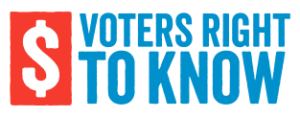THE PROBLEM
American democracy is facing an urgent crisis. Since 2008, more than $1 billion in special interest money has poured into our country’s elections completely out of public view. In our most recent presidential election, even foreign governments were able to successfully purchase and run thousands of ads designed to sway voter opinion. The problem of secret special interest money is out of control, and as political campaigning moves increasingly into the digital realm, it’s only getting worse.
The consequence of unaccountable campaign spending is that our government no longer represents us. Policy outcomes consistently reflect the will of special interests, not the public interest. In turn, this has led to widespread public cynicism and apathy, as reflected by increasingly low voter turnout.
Without a strategic intervention, the vicious cycle of unaccountability, unresponsiveness, and disengagement plaguing American democracy will only continue. We must take action to shift the balance of power away from the undue influence of special interests and back toward the people.
THE SOLUTION
The accountability of our government depends on the ability of voters to make informed decisions on Election Day that represent their interests. This means that as voters consider the many paid political messages seeking to influence their votes, they must be able to properly judge each message’s credibility—which requires being able to know the financial interests behind it.
The Voters’ Right to Know Project is a nonpartisan effort to promote the accountability of American politics by advancing effective state-level policy surrounding the transparency of political spending. We advocate for states to adopt a comprehensive set of solutions that together comprise a new standard of transparency policy—one that will give voters access to the information they need to represent their own interests at the ballot box.
THE STRATEGY
- Generate evidence. We’re spearheading first-of-its-kind normative and cognitive research on political transparency to identify the most popular and effective policy formulations.
- Develop model policy. In partnership with the nation’s top experts, we’re building on our research to develop policy that realizes the strongest possible standards of transparency.
- Run and win state-level campaigns. With gridlock at the federal level, states represent the highest value opportunity to advance the new standard of transparency policy that we propose.

